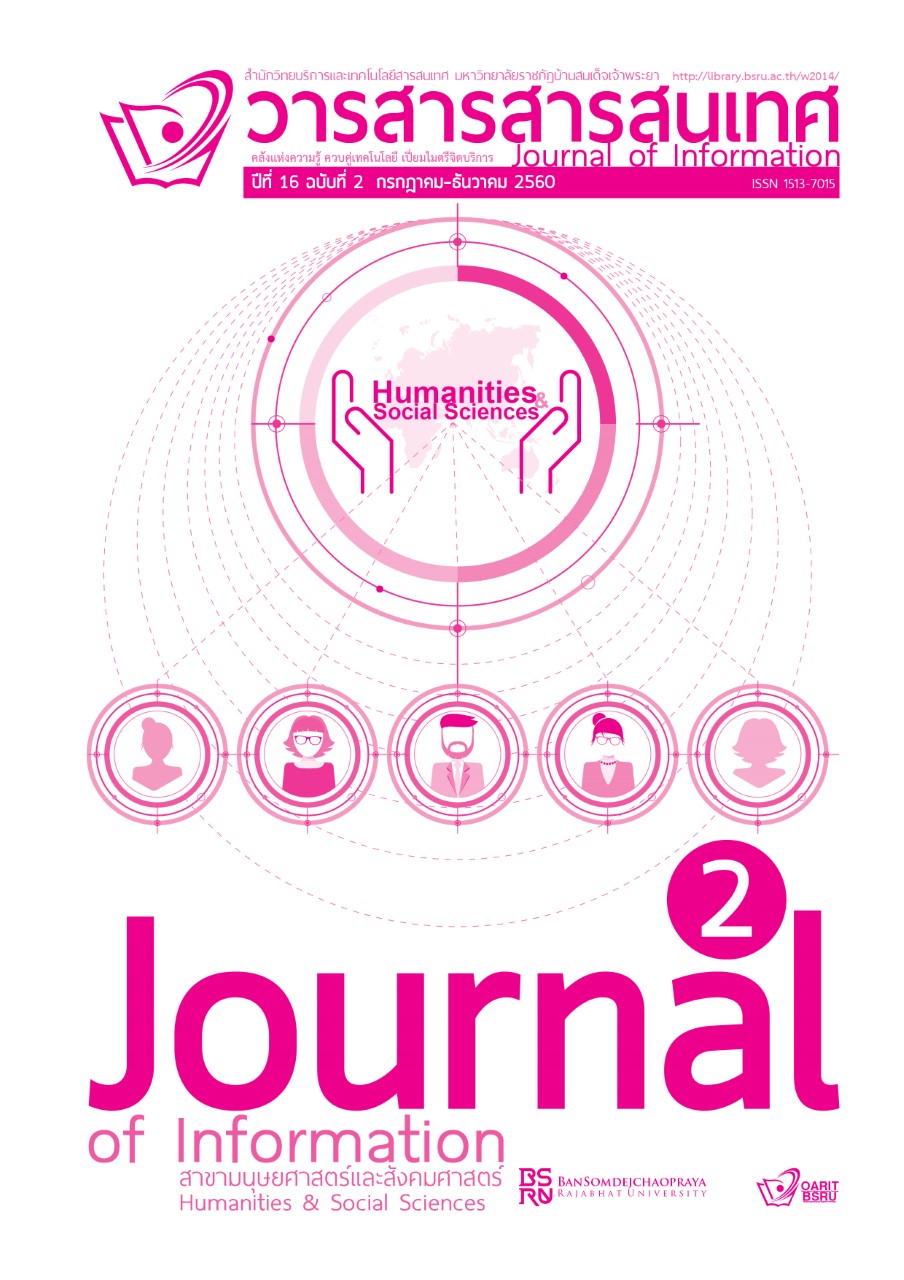รูปแบบการอนุรักษ์สิ่งแวดล้อมของชุมชนกรณีศึกษา:ชุดโครงการวิจัยและพัฒนา การเรียนการสอนวิทยาศาสตร์ท้องถิ่น เครือข่ายมหาวิทยาลัยราชภัฏ :The Environmental Conversation Model for Communities : A case Study of Local Science Projects Under Rajabhat University...
Keywords:
รูปแบบการอนุรักษ์สิ่งแวดล้อมของชุมชน, วิทยาศาสตร์ท้องถิ่นAbstract
บทคัดย่อ
การวิจัยครั้งนี้มีวัตถุประสงค์ เพื่อศึกษาและพัฒนารูปแบบการอนุรักษ์สิ่งแวดล้อมที่มีความเหมาะสมและสอดคล้องกับบริบทของชุมชน ด้วยวิธีการวิจัยเชิงคุณภาพ มีขั้นตอนการในดำเนินการประกอบด้วย 1) การวิเคราะห์และประเมินเอกสารรายงานการวิจัยจากชุดโครงการวิจัยและพัฒนาการเรียนการสอนวิทยาศาสตร์ท้องถิ่น เครือข่ายมหาวิทยาลัยราชภัฏ จำนวน 33 เล่ม 2) คัดเลือกเอกสารรายงานการวิจัยวิทยาศาสตร์ท้องถิ่นฯ ที่มีระดับความสอดคล้องและเหมาะสมของวิธีปฏิบัติในการอนุรักษ์สิ่งแวดล้อมเพื่อเป็นตัวแทนของกลุ่มภูมิภาค จำนวน 6 เล่ม 3) จัดทำร่างรูปแบบการอนุรักษ์สิ่งแวดล้อมของชุมชนโดยผ่านการตรวจสอบความคิดเห็นของผู้เชี่ยวชาญจำนวน 6 ท่าน 4) นำร่างรูปแบบการอนุรักษ์สิ่งแวดล้อมของชุมชนที่ได้ไปสัมภาษณ์หัวหน้าโครงการวิจัยฯ และคณะผู้ร่วมงานจำนวน 18 คน 5) นำผลการวิเคราะห์มาสรุปเป็นรูปแบบการอนุรักษ์สิ่งแวดล้อมของชุมชน และ 6) นำรูปแบบการอนุรักษ์สิ่งแวดล้อมของชุมชนที่ได้ให้ผู้ทรงคุณวุฒิจำนวน 3 ท่าน ตรวจสอบความสมบูรณ์และถูกต้อง สำหรับเครื่องมือที่ใช้ในการวิจัยเป็นแบบวิเคราะห์เอกสาร และแบบสัมภาษณ์ สถิติที่ใช้ได้แก่ ค่าความถี่ ร้อยละ และการวิเคราะห์ข้อมูลเชิงเนื้อหา (content analysis)
ผลการวิจัยพบว่า รูปแบบการอนุรักษ์สิ่งแวดล้อมของชุมชน กรณีศึกษาโครงการวิจัยและพัฒนาการเรียนการสอนวิทยาศาสตร์ท้องถิ่น เครือข่ายมหาวิทยาลัยราชภัฏ ประกอบด้วย 3 องค์ประกอบหลัก คือ 1) หลักการและแนวคิดการอนุรักษ์สิ่งแวดล้อม 2) วัตถุประสงค์ของรูปแบบการอนุรักษ์สิ่งแวดล้อม และ 3) ขั้นตอนในการดำเนินการอนุรักษ์สิ่งแวดล้อม โดยองค์ประกอบที่ 1) หลักการและแนวคิดการอนุรักษ์สิ่งแวดล้อมของชุมชน อยู่บนพื้นฐานของแนวคิดและทฤษฎีด้านกระบวนการเรียนรู้แบบมีส่วนร่วมและวิทยาการด้านสิ่งแวดล้อมที่ผสมผสานเชื่อมโยงกับวิถีชีวิต ภูมิปัญญาและสภาพแวดล้อมของชุมชน โดยมีเป้าหมายเพื่อให้เกิดการใช้ประโยชน์ทรัพยากรธรรมชาติและสิ่งแวดล้อมที่ยั่งยืน การฟื้นฟูทรัพยากรธรรมชาติและสิ่งแวดล้อมที่เสื่อมโทรม และการสงวนทรัพยากรธรรมชาติและสิ่งแวดล้อมที่หายาก สำหรับองค์ประกอบที่ 2) วัตถุประสงค์ เพื่อให้เป็นกระบวนการในการดำเนินงานให้เกิดการใช้ทรัพยากรธรรมชาติและสิ่งแวดล้อมที่เหมาะสมกับบริบทของชุมชน และองค์ประกอบที่ 3) ขั้นตอนในการอนุรักษ์สิ่งแวดล้อมของชุมชน ประกอบด้วย 3 ขั้นตอนย่อย ดังนี้
ขั้นตอนที่ 1 การสร้างความรู้ความเข้าใจ และความตระหนักร่วมกันในการใช้ประโยชน์ทรัพยากรธรรมชาติและสิ่งแวดล้อมของชุมชนอย่างยั่งยืน (ระยะก่อเกิด)
ขั้นตอนที่ 2 การพัฒนากิจกรรมการอนุรักษ์ ด้วยทักษะกระบวนการแลกเปลี่ยนเรียนรู้ เชิงปฏิบัติ เพื่อปรับปรุง/แก้ไขทรัพยากรธรรมชาติและสิ่งแวดล้อมที่เสื่อมโทรม/เปลี่ยนแปลงไป (ระยะพัฒนา)
ขั้นตอนที่ 3 การควบคุมและการเผยแพร่กิจกรรมเพื่อเพิ่มสมรรถนะด้านการอนุรักษ์ทรัพยากรธรรมชาติและสิ่งแวดล้อมของชุมชนให้ยั่งยืน (ระยะขยายผล)
Abstract
The purposes of this research were 1) to investigate and develop model of environment conservation relevant to the community context through qualitative research method with the following processes, i.e., 1) analysis and assessment of 33 research and development project for local science instruction reports of Rajabhat University Network 2) selection of 6 reports which presented the good practice of environment conservation as regional representatives 3) preparation of a draft of community environment conservation model assessed by 6 specialists 4) interviewing 18 research project head and co-researchers regarding the draft of the model 5) validation of the obtained model by 3 experts. Data were collected using documentation and interview protocol and were statistically analyzed by frequency, percentage and use of content analysis.
The findings revealed that the community environment conservation model as appearing in the case of research and development project for local science instruction of Rajabhat University Network delineated 3 components: 1) principle and concept 2) objectives and 3) methods. The principle and concept were based on participatory learning theory and environmental knowledge connected with way of life, local wisdom and community environment to reach the goal of sustainable exploitation of the natural resource, recovery of natural resource and deteriorated environment and conservation of rare natural resource and environment. The objectives were assigned as to provide an outline of appropriate natural resource and environment exploitation based on the community context. Methods included the following 3 steps:
Step 1: Raising convergent understanding and awareness of sustainable exploitation of the natural resource and community environment (Initiative phase).
Step 2: Developing conservation activities in terms of practical knowledge management to improve the deteriorated natural resource and environment (Developmental phase).
Step 3: Controlling and propagating activities to increase the potentiality in sustainable natural resource and environment conservation (Expanding phase).
Downloads
Published
How to Cite
Issue
Section
License
บทความ ข้อความ ภาพประกอบ และตารางประกอบที่ลงพิมพ์ในวารสารเป็นความคิดเห็นส่วนตัวของผู้นิพนธ์ กองบรรณาธิการไม่จำเป็นต้องเห็นตามเสมอไป และไม่มีส่วนรับผิดชอบใดๆ ถือเป็นความรับผิดชอบของผู้นิพนธ์เพียงผู้เดียว






